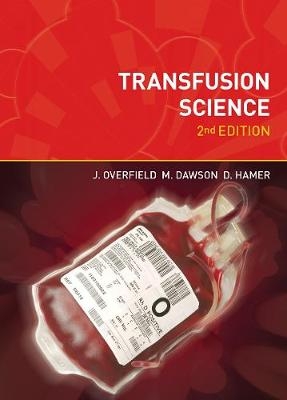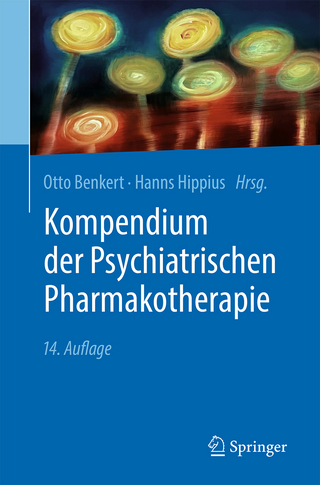
Transfusion Science, second edition
Scion Publishing Ltd (Verlag)
978-1-904842-40-8 (ISBN)
The book has a revised design and layout, and includes a greater number of case studies, to aid student understanding.
There have been a number of significant changes in transfusion science in the last five to ten years and this second edition of Transfusion Science covers these in some detail.
* A new chapter introduces readers to the current applications of emerging techniques in transfusion science.
* Platelet immune disorders and haemolytic anaemias are now covered.
* The need for leucodepletion and methods for pathogen reduction are described.
* The latest nomenclature for blood group genes has been adopted.
* Current practice in blood group serology is reviewed.
* Recent legislative changes for quality assurance in transfusion in the UK are now also covered.
Case studies and colour photographs are now provided to illustrate concepts and to aid understanding, and a revised series of self-assessment questions and learning outcomes are also provided.
An understanding of transfusion science is vital for all biomedical science students. Transfusion Science, second edition, explains all the basic principles alongside descriptions of the applications now possible as a result of modern analytical techniques. This book is essential reading for all students studying courses on transfusion and transplantation.
1. The immune system
1.1 Immunology and transfusion science; 1.2 The immune system; 1.3 Two types of immune defence; 1.4 Non-specific defences; 1.5 Non-specific responses to tissue damage and infection; 1.6 The specific immune response; 1.7 Cells of the specific immune response
2. Antibodies and antigens
2.1 History of antibodies; 2.2 Antibodies are immunoglobulins; 2.3 Kinetics of the antibody response; 2.4 Immunoglobulin isotypes; 2.5 Antibody structure; 2.6 Binding of an antibody to an epitope; 2.7 Effector role of the antibody
3. Complement
3.1 Historical context; 3.2 Complement is not a single entity; 3.3 The classical pathway: activation to lysis; 3.4 Other biological activities of complement; 3.5 Alternative pathway for complement activation; 3.6 The lectin pathway; 3.7 Physiological regulation of complement activation; 3.8 Complement in transfusion science
4. Genetics for blood groups
4.1 Genetics and blood groups; 4.2 DNA and chromosomes; 4.3 The structure and role of genes; 4.4 DNA replication and protein synthesis; 4.5 Blood groups and molecular events in genes; 4.6 Inheritance of blood group genes
5. Introduction to blood groups: the ABO blood group system
5.1 Introduction; 5.2 Blood group nomenclature; 5.3 The ABO blood group system; 5.4 The biochemical nature of the A and B antigens; 5.5 genes involved in the ABO system; 5.6 Secretors of A,B and H sugars; 5.7 The FUT1 (H) gene and the Bombay blood groups; 5.8 Inheritance and molecular genetics of the ABO groups; 5.9 Sub-groups of A and B blood groups; 5.10 Population distribution of the ABO groups; 5.11 The distribution of ABO determining antigens; 5.12 ABO blood group antibodies
6 The Rh blood group system
6.1 Introduction to the Rh system; 6.2 Inheritance and nomenclature of the Rh system; 6.3 Fisher' s dce system; 6.4 Two locus model; 6.5 Qualitative differences in Rh antigens; 6.6 Quantitative differences in Rh antigens; 6.7 Laboratory aspects of Rh blood group typing
7. Other blood group systems
7.1 Carbohydrate antigens; 7.2 Protein antigens; 7.3 Importance of other blood groups in transfusion science
8. Immune and auto immune haematology disorders
8.1 Mechanisms of red cell destruction; 8.2 Causes and classification of immune haemolytic anaemia; 8.3 Haemolytic transfusion reactions; 8.4 Warm auto immune haemolytic anaemia; 8.5 Cold haemolytic anaemia; 8.6Underlying mechanisms which may cause immune/auto immune haemolytic anaemia; 8.7 Drug induced haemolytic anaemia; 8.8 Laboratory tests for diagnosis of auto immune / immune haemolytic anaemia; 8.9 Haemolytic disease of the newborn; 8.10 Immune disorders affecting platelets
9. Blood products and components
9.1 Introduction to blood components; 9.2 Blood components for transfusion; 9.3 Plasma derived blood components; 9.4 Plasma derived products from single donations; 9.3 Quality assurance procedures for blood and blood products
10. Haemagglutination and blood grouping methods
10.1 Introduction; 10.2 Haemagglutination; 10.3 Methods; 10.4 Technical considerations; 10.5 Associated technical considerations;
11. Adverse effects of transfusion
11.1 General precautions; 11.2 Adverse effects caused by transmission of infectious agents; 11.3 Adverse reactions due to the transfusion of red; cells; 11.4 Adverse reactions due to the transfusion of leucocytes; 11.5 Adverse reactions due to the transfusion of platelets; 11.6 Adverse reactions due to the transfusion of plasma; 11.7 Adverse reactions due to other causes; 11.8 Investigation of an alleged reaction to a red cell transfusion; 11.9 Summary
12. Stem cell processing and transplantation
12.1 Introduction; 12.2 Some useful definitions; 12.3 Clinical situations requiring a haemopoietic stem cell transplant; 12.4 Sources and processing of haemopoietic stem cells for transplant; 12.7 Transfusion support post transplant; 12.7 Problems associated with the transplantation of haemopoietic stem cell transplants; 12.8 The major histocompatibility complex; 12.9 The HLA system;l; 12.10 Availability and choice of donors
13. Applications of molecular and immunological techniques
13.1 Introduction ; 13.2 Molecular techniques for the identification of blood groups; 13.3 Applications of molecular techniques; 13. 4 Further applications of molecular techniques; 13.5 Immunological techniques using flow cytometry
| Erscheint lt. Verlag | 29.11.2007 |
|---|---|
| Verlagsort | Bloxham |
| Sprache | englisch |
| Maße | 171 x 243 mm |
| Gewicht | 577 g |
| Themenwelt | Medizin / Pharmazie ► Medizinische Fachgebiete ► Pharmakologie / Pharmakotherapie |
| ISBN-10 | 1-904842-40-2 / 1904842402 |
| ISBN-13 | 978-1-904842-40-8 / 9781904842408 |
| Zustand | Neuware |
| Informationen gemäß Produktsicherheitsverordnung (GPSR) | |
| Haben Sie eine Frage zum Produkt? |
aus dem Bereich


